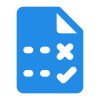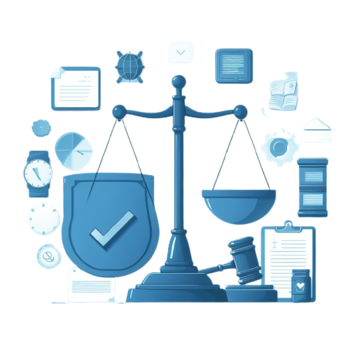What is employee attendance sheet?
An employee attendance sheet is a fundamental tool used by organizations to meticulously record and manage the attendance of their workforce. It serves as a structured document or digital record where employees' daily attendance, including clock-in and clock-out times, is meticulously documented. This essential document allows businesses to monitor employee punctuality, track absenteeism, and ensure compliance with attendance policies.
The employee attendance sheet typically includes crucial information such as:
1. Employee Names:
A list of all employees for whom attendance is being tracked.
2. Date:
The specific date for each attendance entry.
3. Clock-In and Clock-Out Time:
The times at which employees start and finish their workday.
4. Break Times:
If applicable, the duration and timing of breaks are often recorded to monitor adherence to break policies.
5. Total Hours Worked:
The cumulative number of hours worked by each employee during a given period, usually calculated based on clock-in and clock-out times.
6. Overtime:
If employees work beyond their regular hours, overtime hours are recorded separately.
7. Attendance Codes:
These codes may be used to denote different types of attendance, such as vacation days, sick leave, or holidays.
The employee attendance sheet serves several essential purposes within an organization:
1. Attendance Monitoring:
It provides a clear and systematic record of employee attendance, enabling employers to track employee punctuality and identify attendance trends.
2. Payroll Processing:
The data recorded on the attendance sheet serves as a basis for calculating employee salaries and wages, factoring in overtime and other attendance-related variables.
3. Compliance:
Employee attendance sheets help organizations ensure compliance with labor laws, employment contracts, and attendance policies.
4. Leave Management:
They facilitate the management of various types of leave, such as sick leave, vacation days, and personal time off.
5. Performance Evaluation:
Attendance records can be used as part of employee performance evaluations, providing insights into an employee's commitment and reliability.
While traditional attendance sheets were often paper-based, modern organizations frequently use digital employee attendance tracking systems or specialized software. These digital solutions offer real-time tracking, automation, and enhanced data security, streamlining attendance management and making it more efficient. In summary, an employee attendance sheet is a vital tool that helps organizations maintain accurate attendance records, ensuring workforce reliability, payroll accuracy, and compliance with attendance policies. Whether in a traditional or digital format, it remains an indispensable part of effective workforce management.
The Power of Employee Monitoring Software in Attendance Tracking
In today's dynamic workplace environment, the concept of employee monitoring software has evolved to encompass a wide array of functions, with attendance tracking being a key area of application. This software plays a pivotal role in ensuring accurate, efficient, and hassle-free attendance management for organizations of all sizes. Let's delve into the concept of employee monitoring software and explore its crucial role in attendance tracking.
Understanding Employee Monitoring Software
Employee monitoring software is a comprehensive solution designed to help businesses monitor and manage various aspects of their workforce, including attendance. It leverages technology to automate and streamline attendance tracking processes, reducing the reliance on manual, error-prone methods.
Download Super Time Tracking Tools for Maximum Efficiency
The Role of Employee Monitoring Software in Attendance Tracking

Automated Attendance Recording
Employee monitoring software simplifies the attendance tracking process by automating the recording of employee clock-ins and clock-outs. This eliminates the need for time-consuming manual data entry, reducing errors and ensuring accuracy.
.png)
Real-Time Data
Modern monitoring software provides real-time attendance data, enabling supervisors and HR personnel to monitor employee attendance as it happens. This feature is particularly valuable for businesses with remote or flexible work arrangements.

Comprehensive Reporting
These software solutions generate detailed attendance reports, allowing organizations to gain valuable insights into attendance patterns, trends, and compliance. Customizable reporting features enable tailored analysis to meet specific business needs.

Integration with HR Systems
Employee monitoring software seamlessly integrates with HR systems, creating a unified platform for workforce management. This integration ensures that attendance data is synchronized with other HR functions, such as payroll processing and leave management.

Remote Work Support
With the rise of remote work, employee monitoring software provides essential tools for tracking attendance, even for employees working from various locations. Mobile-friendly access allows for efficient attendance management on the go.

Scalability
These solutions offer scalability, making them well-suited for organizations of any size. Whether you manage a small team or a sprawling enterprise, employee monitoring software can flexibly accommodate your requirements.

Customization
Many software options allow for customization to meet specific attendance tracking requirements. This flexibility ensures that the software aligns with the unique needs and workflows of different industries.

Enhanced Security
Data security is a paramount concern. Employee monitoring software offers robust security measures to protect sensitive attendance data, ensuring compliance with data privacy regulations.
Employee monitoring software is a versatile and indispensable tool for modern businesses looking to streamline attendance tracking. Its role extends beyond just recording clock-ins and clock-outs; it empowers organizations with real-time data, enhanced security, scalability, and customization options. By embracing this technology, businesses can achieve greater accuracy, efficiency, and compliance in attendance management, ultimately contributing to overall operational excellence.
Benefits of Employee Attendance Sheet with Employee Monitoring Software
Employee attendance sheets, when integrated with employee monitoring software, offer numerous advantages for organizations. This combination enhances attendance tracking accuracy and streamlines data collection processes, ultimately leading to improved workforce management. Here's how it achieves these benefits:
1. Enhanced Attendance Tracking Accuracy:
• Real-Time Tracking: Employee monitoring software provides real-time attendance tracking capabilities. When employees clock in and out using the software, the data is recorded instantly and accurately. This eliminates errors and ensures that attendance records are always up to date. • Automated Data Entry: The software automates the process of recording attendance data, reducing the risk of human errors associated with manual data entry. This automation means that attendance records are based on precise and verified information. • Customizable Attendance Policies: Employee monitoring software allows organizations to define and customize attendance policies. These policies can include rules for punctuality, tardiness, and leave management. Customization ensures that attendance tracking aligns with the company's specific requirements, enhancing accuracy in adherence to attendance rules.
2. Streamlined Attendance Data Collection:
• Automation: : Employee monitoring software streamlines attendance data collection by automating many aspects of the process. Employees can easily clock in and out using the software, reducing the need for manual intervention. This automation saves time and reduces the administrative burden associated with attendance tracking. • Integration with HR Systems: TMany employee monitoring solutions seamlessly integrate with other HR systems, such as payroll and leave management software. This integration ensures that attendance data is synchronized across various HR functions, minimizing data discrepancies and improving overall HR efficiency. • Efficient Reporting and Analytics: Employee monitoring software typically includes reporting and analytics tools. These features make it easy for organizations to generate detailed attendance reports, analyze attendance patterns, and identify trends. By streamlining the reporting process, organizations can make data-driven decisions to optimize attendance management strategies.
In conclusion, employee attendance sheets combined with employee monitoring software offer a range of benefits, including enhanced attendance tracking accuracy and streamlined data collection. Real-time tracking, automated data entry, customizable policies, automation, integration with HR systems, and efficient reporting and analytics contribute to more efficient and accurate attendance management. This, in turn, helps organizations make informed decisions, improve workforce planning, and ensure compliance with attendance policies.
Key Features of Employee Monitoring Software
Employee monitoring software is a versatile solution crafted to optimize different facets of workforce management, including the crucial task of attendance tracking. In the following sections, we will delve into the pivotal features of this software and their role in fostering efficient attendance management.
1. Real-Time Attendance Tracking:
• Contribution to Attendance Management: Real-time attendance tracking allows organizations to monitor employee attendance as it happens. Supervisors and HR personnel can instantly view who is present or absent, facilitating quick responses to attendance issues and better workforce planning.
2. Automated Clock-Ins and Clock-Outs:
• Contribution to Attendance Management: Automated clock-ins and clock-outs reduce the burden of manual data entry, minimizing errors and ensuring accurate attendance records. This automation streamlines the attendance tracking process, saving time and resources.
3. Customizable Attendance Policies:
• Contribution to Attendance Management: Employee monitoring software often enables organizations to establish and customize attendance policies. This feature ensures that attendance tracking aligns with company-specific rules, such as defining tardiness thresholds and tracking various types of leave.
4. Reporting and Analytics:
• Contribution to Attendance Management: Robust reporting and analytics capabilities provide valuable insights into attendance patterns, trends, and compliance. Organizations can generate detailed reports to monitor attendance KPIs and make data-driven decisions to improve attendance management strategies.
5. Integration with HR Systems:
• Contribution to Attendance Management: Integration with HR systems, help for payroll and leave management, ensures that attendance data is seamlessly synchronized across different HR functions. This integration reduces data discrepancies and enhances overall HR efficiency.
6. Geolocation and Mobile Access:
• Contribution to Attendance Management: For remote or field-based employees, geolocation tracking ensures that attendance is accurately recorded based on their location. Mobile access allows employees to clock in and out using their smartphones, providing flexibility for those working outside the office.
7. Alerts and Notifications:
• Contribution to Attendance Management: Employee monitoring software can send alerts and notifications to supervisors and HR personnel when attendance irregularities occur. This proactive feature enables timely intervention and corrective actions for attendance issues.
8. Data Security and Compliance:
• Contribution to Attendance Management: Robust security measures protect attendance data from unauthorized access. Employee monitoring software also helps organizations maintain compliance with data privacy regulations, ensuring that sensitive attendance information is handled securely.
9. Employee Self-Service Portals:
• Contribution to Attendance Management: Self-service portals empower employees to view and manage their own attendance records. This feature reduces administrative overhead by allowing employees to request time off, check their attendance history, and update personal information independently.
10. Scalability:
• Contribution to Attendance Management: Scalability ensures that employee monitoring software can accommodate the needs of growing organizations. Whether a business has a small team or a large workforce, the software can adapt to meet changing attendance tracking demands.
In conclusion, the key features of employee monitoring software, such as real-time tracking, automation, customization, reporting, and integration, play a pivotal role in effective attendance management. These features enhance accuracy, efficiency, and compliance, ultimately allowing organizations to streamline attendance tracking processes and make informed decisions to optimize workforce attendance.
"Start Simplifying Attendance Today!"



